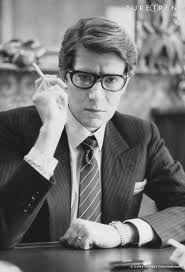Yves Saint Laurent
Contents
Country
France
Birth - Death
1936 - 2008
Occupation
Fashion
Notable Achievements
Grand officier de la Légion d'honneur
Description
Carrying on the success in the fashion industry of his mentor, Christian Dior, Yves Saint Laurent continued to innovate by popularizing the ready-to-wear fashion line. Doing so made him one of the great names in fashion.
Entering the world of fashion at the young age of 18, Saint Laurent enrolled at the Paris-based Chambre Syndicale de la Haute Couture. At the time, fashion to Saint Laurent was an escape from the taunts and bullying he often received for his effeminate personality. His work was so popular that he was soon introduced to the greatest fashion designer of his time, Christian Dior, who hired him on the spot. Within a few short years Dior had chosen Yves Saint Laurent to succeed him as head designer, a position Yves inherited at the young age of 21 with Dior’s death. His first collection, the Ligne Trapeze, was an international success, won him the Neiman Marcus Oscar, and ensured the continued viability of the House of Dior.
Saint Laurent interrupted his work in the fashion industry in 1942 when he was conscripted into the French army. This was a traumatic experience for him and caused a mental breakdown. While in hospital, he was advised that he was fired from the House of Dior. He successfully sued for breach of contract.
On his release, Saint Laurent met the man who would be his lifelong business and romantic partner, Pierre Berge. They started the Yves Saint Laurent YSL fashion house in 1962.
To distinguish himself in the market, Yves Saint Laurent was the first fashion house to introduce a full prêt-a-porter (ready-to-wear) fashion line of clothing. He popularized such clothing as women’s trousers, sheer blouses, the peasant look, and ethnic costume. The ready-to-wear line allowed women around the world the opportunity to afford a part of the YSL dream.
This YSL brand became the world’s most popular ready-to-wear fashion line in the world. During the late 1960s and early 1970s he introduced accessories such as jewelry, perfumes, linens, and expanded into men’s wear. Saint Laurent easily associated with celebrities and the jet set, which enhanced the marketing effort.
Unfortunately, both this and the pressure of producing two new lines of fashion per year led him to increasingly abuse alcohol and drugs. He became a tortured, intense individual who worked himself up to hysterics under pressure, yet remained shy and childlike in public. Saint Laurent increasingly relied on his partner, Pierre Berge, to be the face of the company. For a time, the two separated because of their violent personal clashes. In the end, Yves withdrew from the public realm. His world became reduced to his studio and their vacation home in Morocco.
Yves continued designing until 2002. In the interim, he received numerous public recognitions and rewards. In 1983 the Metropolitan Museum of Art held its first-ever retrospective of a fashion designer when it featured Yves Saint Laurent. He was appointed a Commander of the Legion d’Honneur in 2001 and was upgraded to the rank of Grand Officer in 2007. His fashion house created a new generation of important designers, such as American Tom Ford who was creative designer from 1999-2004 after Gucci bought the company.
Saint Laurent died in 2007 from brain cancer one week after he and Pierre Berge entered into a same-sex civil union. In 2009, an extensive auction of his art and furniture collection was a world-wide phenomenon that generated in excess of US$ 477 in sales. Two popular films of his life have recently been produced.
The creative genius of Yves Saint Laurent that emanated from a shy, introverted and effeminate young individual had transformed the global fashion industry into a series of international brands accessible to the general public. The process took its toll on the mental state of Saint Laurent, but he was fortunate to have been in a long-term committed relationship with an opposite, the businessman Berge. Perhaps Yves’ efforts at successfully producing women’s wear that reflected simplicity of style with a message of power and comfort was a reflection of his own personal ambitions in life.
See Also
- Gay Menswear Fashion Designers
- LGBTQ Individuals Who Have Received France's Highest Honours
- LGBTQ Jewellery Designers
- Prominent Furniture Designers Who Identify as LGBTQ
- Creative Directors of Fashion Houses Who Are LGBTQ
- Expert LGBTQ Perfumers

